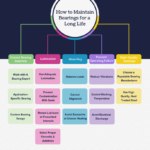Bearing costs are rising due to a number of reasons. Below is a breakdown of what is driving the impact on production and delivery.
Production
Two inputs that impact production are raw materials and employee wages.
Demand for steel fell during the early months of the Coronavirus. The sharp decline caused many steel mills to limit production. Early decreases in output and rebounding economic activity has added to price volatility.
Salaries are being adjusted throughout China as factory workers have more employment options. A growing service sector and opportunities closer to home are forcing factories to increase salaries to attract talent.
Logistics

Containers – Trade imbalance is evident by the volume of empty containers sitting in US yards while China scrambles to find available containers.
Shipping – Chinese manufacturers rush to get product to customers before Lunar New Year. This year, the export increase coupled with the two-week holiday is forcing premium fees for space on vessels.
Exchange Rate & Bearing Costs
The dollar has continued depreciating over the past months. With a majority of bearings manufactured outside of the US, many companies are experiencing increase costs.
The CNY/RMB has strengthened since June – in line with the country’s rapid economic recovery from the coronavirus pandemic. The twin monetary fluctuations are impacting costs.

